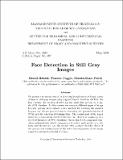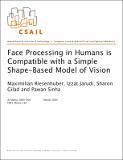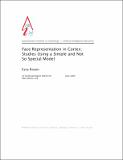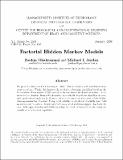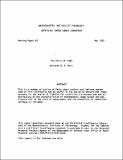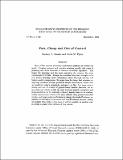Browsing Artificial Intelligence Lab Publications by Title
Now showing items 527-546 of 1835
-
Face Detection in Still Gray Images
(2000-05-01)We present a trainable system for detecting frontal and near-frontal views of faces in still gray images using Support Vector Machines (SVMs). We first consider the problem of detecting the whole face pattern by a single ... -
Face processing in humans is compatible with a simple shape-based model of vision
(2004-03-05)Understanding how the human visual system recognizes objects is one of the key challenges in neuroscience. Inspired by a large body of physiological evidence (Felleman and Van Essen, 1991; Hubel and Wiesel, 1962; Livingstone ... -
Face Recognition from One Example View
(1995-09-01)If we are provided a face database with only one example view per person, is it possible to recognize new views of them under a variety of different poses, especially views rotated in depth from the original example ... -
Face Recognition Under Varying Pose
(1993-12-01)While researchers in computer vision and pattern recognition have worked on automatic techniques for recognizing faces for the last 20 years, most systems specialize on frontal views of the face. We present a face recognizer ... -
Face Representation in Cortex: Studies Using a Simple and Not So Special Model
(2003-06-05)The face inversion effect has been widely documented as an effect of the uniqueness of face processing. Using a computational model, we show that the face inversion effect is a byproduct of expertise with respect to the ... -
Factorial Hidden Markov Models
(1996-02-09)We present a framework for learning in hidden Markov models with distributed state representations. Within this framework, we derive a learning algorithm based on the Expectation--Maximization (EM) procedure for maximum ... -
The Facts of Light
(MIT Artificial Intelligence Laboratory, 1975-05)This is a random collection of facts about radiant and luminous energy. Some of this information may be useful in the design of photo-diode image sensors, in the set-up of lighting for television microscopes and the ... -
A Fair Power Domain for Actor Computations
(MIT Artificial Intelligence Laboratory, 1979-06)Actor-based languages feature extreme concurrency, allow side effects, and specify a form of fairness which permits unbounded nondeterminism. This makes it difficult to provide a satisfactory mathematical foundation for ... -
Fan-beam Reconstruction Methods
(1977-11-01)In a previous paper a technique was developed for finding reconstruction algorithms for arbitrary ray-sampling schemes. The resulting algorithms use a general linear operator, the kernel of which depends on the details ... -
Fast Arithmetic in MACLISP
(1977-09-01)MacLISP provides a compiler which produces numerical code competitive in speed with some FORTRAN implementations and yet compatible with the rest of the MacLISP system. All numerical programs can be run under MacLISP ... -
Fast Contour Matching Using Approximate Earth Mover's Distance
(2003-12-05)Weighted graph matching is a good way to align a pair of shapes represented by a set of descriptive local features; the set of correspondences produced by the minimum cost of matching features from one shape to the features ... -
Fast Learning by Bounding Likelihoods in Sigmoid Type Belief Networks
(1996-02-09)Sigmoid type belief networks, a class of probabilistic neural networks, provide a natural framework for compactly representing probabilistic information in a variety of unsupervised and supervised learning problems. ... -
Fast Object Recognition in Noisy Images Using Simulated Annealing
(1995-01-25)A fast simulated annealing algorithm is developed for automatic object recognition. The normalized correlation coefficient is used as a measure of the match between a hypothesized object and an image. Templates are ... -
A Fast Parsing Scheme for Hand-Printed Mathematical Expressions
(1967-10-19)A set of one-line text-book-style mathematical expressions is defined by a context free grammar. This grammar generates strings which describe the expressions in terms of mathematical symbols and some simple positional ... -
Fast Perceptual Learning in Visual Hyperacuity
(1991-12-01)In many different spatial discrimination tasks, such as in determining the sign of the offset in a vernier stimulus, the human visual system exhibits hyperacuity-level performance by evaluating spatial relations with the ... -
Fast Pose Estimation with Parameter Sensitive Hashing
(2003-04-18)Example-based methods are effective for parameter estimation problems when the underlying system is simple or the dimensionality of the input is low. For complex and high-dimensional problems such as pose estimation, ... -
Fast, Cheap and Out of Control
(1989-12-01)Spur-of-the-moment planetary exploration missions are within our reach. Complex systems and complex missions usually take years of planning and force launches to become incredibly expensive. We argue here for cheap, ... -
Fat-Tree Routing for Transit
(1990-02-01)The Transit network provides high-speed, low-latency, fault-tolerant interconnect for high-performance, multiprocessor computers. The basic connection scheme for Transit uses bidelta style, multistage networks to ... -
Fault-Tolerant Design for Multistage Routing Networks
(1990-04-01)As the size of digital systems increases, the mean time between single component failures diminishes. To avoid component related failures, large computers must be fault-tolerant. In this paper, we focus on methods for ... -
Feature Extraction Without Edge Detection
(1993-09-01)Information representation is a critical issue in machine vision. The representation strategy in the primitive stages of a vision system has enormous implications for the performance in subsequent stages. Existing ...

